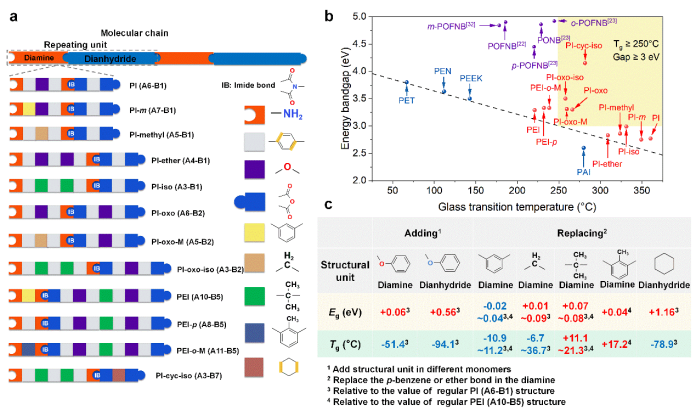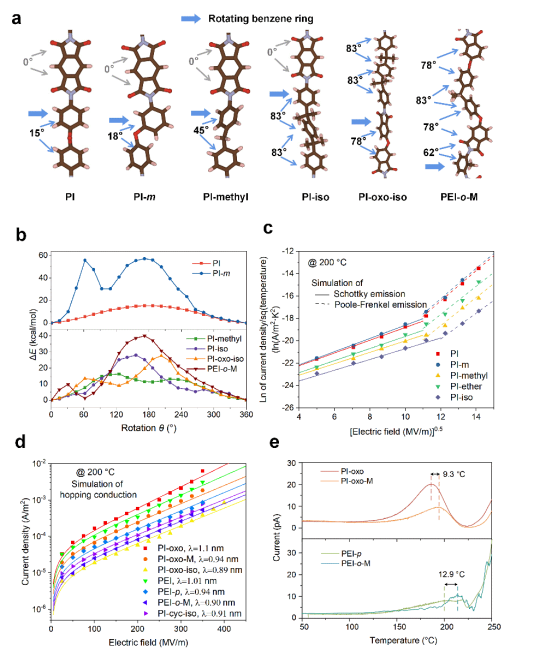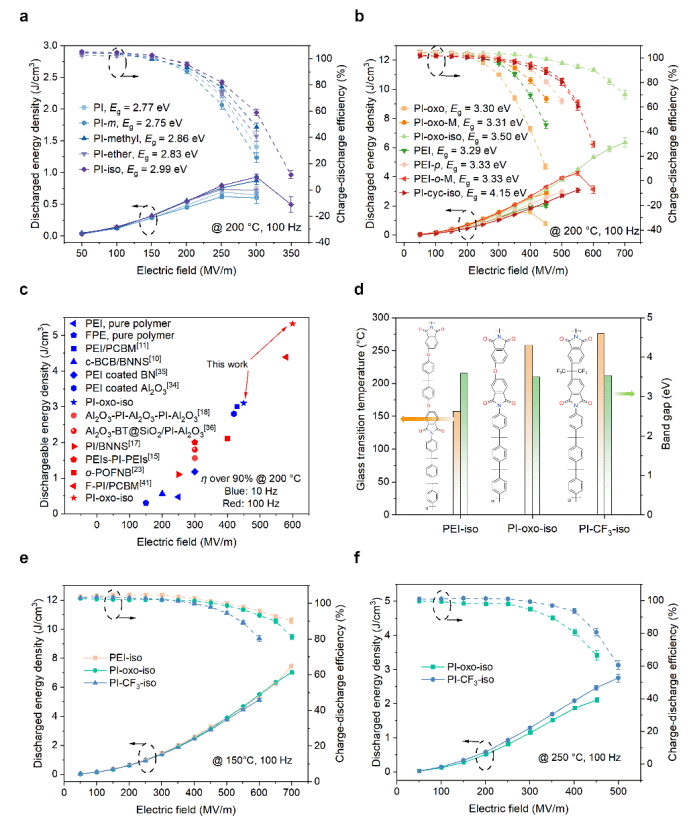Recently, Associate Professor Li Qi’s research team in the Department of Electrical Engineering and Applied Electronics (EEA), Tsinghua University has made new progress in the research on high-temperature capacitive energy storage films. They proposed a design concept of tailored customization and assembly of molecular structural units. By machine learning, molecular dynamics simulating, experimental testing and analyzing, the team has revealed the key molecular structural factors affecting the high-temperature dielectric energy storage properties, and finally made a polymer dielectric film with the highest energy storage density at extreme temperature up to 250°C.
Many mainstream dielectric energy storage technologies in the emergent applications, such as renewable energy, electrified transportations and advanced propulsion systems, are usually required to operate under harsh-temperature conditions (150°C to 250°C). However, as one of the essential basic components in electronic devices and energy systems, thin film capacitors can currently only operate below 105°C, mainly due to the bottleneck problem that conventional polymer dielectric materials suffer high electrical conductivity loss, severe heating and easy thermal runaway of under high temperature and high electric field conditions.
By machine learning, the team predicted the glass transition temperature (Tg) and bandgap (Eg) of 110 types of PI-derived polymer structures from diverse combinations of 21 structural units that possess a wide distribution of electrical and thermal properties. By breaking down the polymer structure into different structural units and synthesizing and systematically studying 12 types of polyimide macromolecules using a modular assembly strategy, the team obtained the quantitative impact of each structural unit on the material Tg and Eg, thereby achieving customization of polymer molecular structures with target properties (Figure 1).

Fig. 1: Modular assembly of structural units and the quantitative impact on material properties
Traditionally, the Eg of dielectrics is considered as the key factor determining high-temperature insulation performance. Therefore, Eg has been an indicator guiding the research of high-temperature capacitive polymer materials for a long time. The team found that in this series of polyimide macromolecules, when Eg reaches a certain critical value, the conduction mechanism will change, and further increasing Eg cannot further improve the high-temperature dielectric energy storage performance of the material. This research result indicates that it is not possible to break through the upper temperature limit of such materials solely by improving the design concept of Eg.
Through molecular dynamics simulation combined with experimental tests, the team also revealed that in this case, the high-temperature dielectric energy storage performance of the material is closely related to the dihedral angle between adjacent conjugated planes in the polymer (Figure 2). Based on this new finding, the team customized the assembly of structural units, designed and prepared high-temperature energy storage polymer dielectrics with excellent performance at 150 °C, 200 °C, and 250 °C (Figure 3). For example, at an extreme temperature of 250 °C, the energy density with a charge and discharge efficiency of over 90% reaches 2.1J/cm3, which is currently the highest level reported.

Fig. 2: Dihedral angle between conjugate planes and the electrical conduction mechanism of materials

Fig. 3: High-temperature energy storage performance of materials with different molecular structures
The high-performance and high-temperature-resistant dielectric polymers obtained in this study are all synthesized by a mature two-step reaction method using monomers from commercial products, which makes large-scale preparation of such high-temperature-resistant dielectric films possible. Meanwhile, the design concept of this research can also be extended to other dielectric polymer systems, which has broad implications for the development of high-temperature dielectric energy storage films.
The research results are published under the title of “Designing Tailored Combinations of Structural Units in Polymer Dielectrics for High-Temperature Capacitive Energy Storage” in the international academic journal Nature Communications.
Postdoctor Wang Rui and Doctoral student Zhu Yujie from EEA are co-first authors of the paper, and Associate Professor Li Qi is the corresponding author of the paper. Other collaborators include Professor He Jinliang and Professor Hu Jun from EEA, Tsinghua University. The research was funded by the National Natural Science Foundation of China.
Paper link: https://www.nature.com/articles/s41467-023-38145-w#Sec2

















 News & Events
News & Events